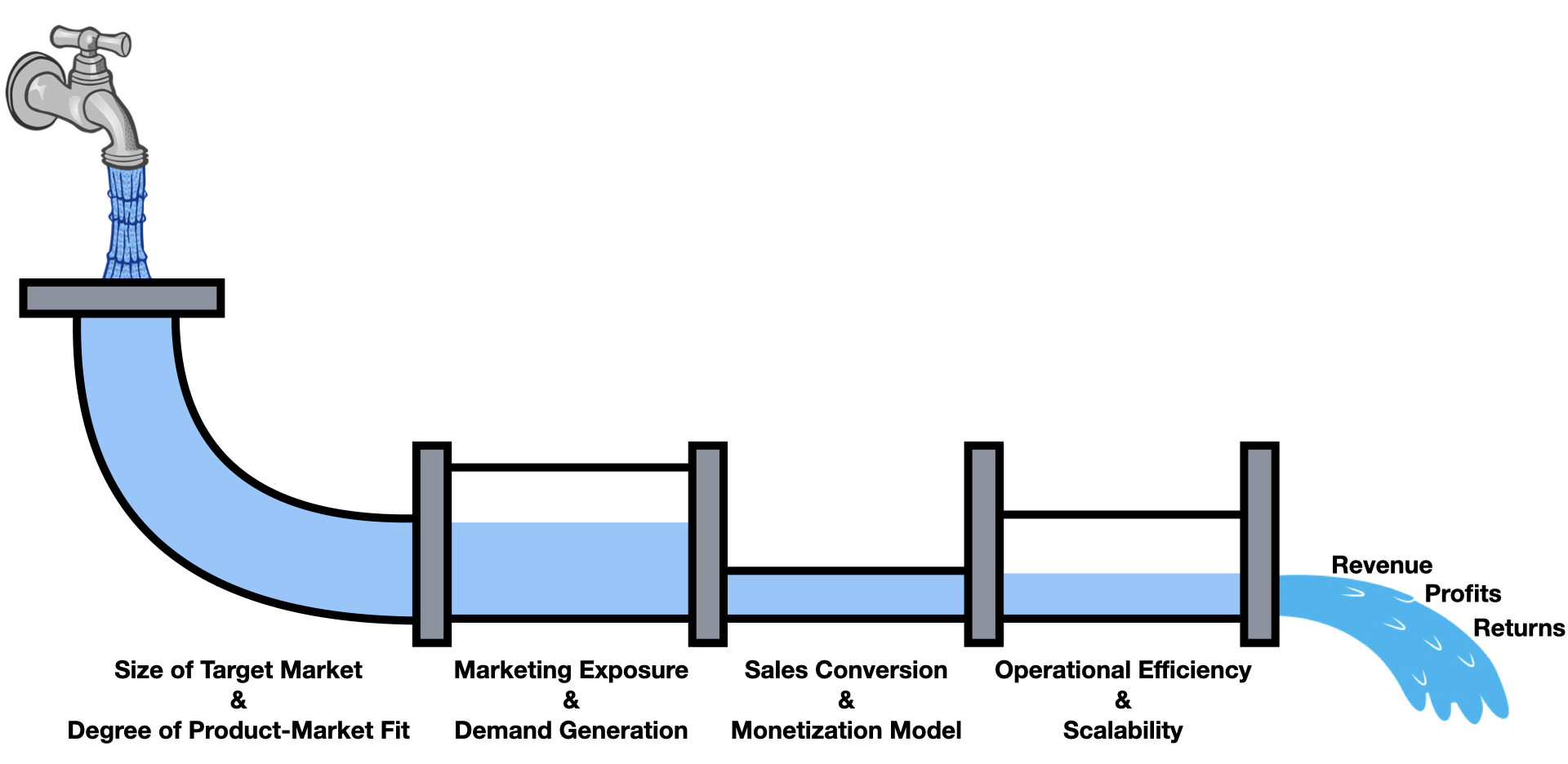There are only two components to growing a business.
Increasing Potential and Removing Constraints.
Potential measures the opportunity (eg. market size, product-market fit and level of demand).
Whereas constraints measure the friction in a business’ ability to convert opportunity into revenue and profit efficiently.
Therefore, as long as there is enough opportunity, the success of a business is actually determined by its ability to remove constraints.
The first step to do so is to…
Step 1: See your business like a pipeline.

Just like a pipeline, the flow of productivity/value/money in a business is limited to the throughput of its weakest link.
Most entrepreneurs usually perform best in 1 of 2 hats: Marketing or Operations.
The most common approach entrepreneurs take towards growth is to double down on what they’re naturally good at (eg. writing more ads or further improving the service delivery).
Hence the saying, “If all you have is a hammer, everything looks like a nail.”
A more effective approach is to identify the weakest link in top-down sequential order of the pipeline and to remove the bottleneck instead of just maximizing on what’s already performing comparatively well.
A great service does not matter if the market does not resonate with it (reflected by their willingness to pay).
A great marketing campaign does not matter if the service does not deliver what clients want.
Find the gaps in your business and fill them with the right help accordingly.
Solving problems in the right order of priority achieves far more results than trying to solve every problem at once.
Step 2: Root Cause Analysis
Every constraint consists of 3 layers: the symptom, the problem and the root cause.
The symptom is the negative effect people can most easily recognize.
The problem is what creates that negative effect.
The root cause is the sequential order of variables that lead up to the problem in the first place.
Here is a general example.
Symptom: there are many slip & fall accidents in the hallway.
Problem: the hallway is always wet
Root Cause: The pipe keeps bursting -> the water pressure is set too high -> the building technician keeps setting the water pressure incorrectly -> the technician manual has not been updated since the most recent plumbing renovation.
By updating the technician manual, every problem downstream can be prevented with no additional or on-going effort.
In comparison, here is what would have happened instead if the Root Cause was not traced to its origins.
The company would have either 1. Kept mopping floors 2. Waste the building manager’s time by checking the water pressure everyday or 3. Kept firing and hiring new technicians.
The process of Root Cause Analysis is to keep asking WHY until the core and source of the issue is uncovered.
Not following this process results in a continuous frenzy of unnecessary chaos, complexity and reactivity … the antithesis of scaling.
“If I had an hour to solve a problem I’d spend 55 minutes thinking about the problem and 5 minutes thinking about solutions.” – Albert Einstein
Fixing problems at the root is the process of preventing problems from reoccurring again.
When businesses can continuously resolve and prevent past problems from repeating again while placing most of its energy into solving continuously higher level problems instead… that is how businesses scale.
Step 3: Compounding Improvements
Growing a company by 2X+ may seem like an impossible task, but it becomes much more manageable once the objective is broken down into bite-size chunks.
Every segment within the proverbial business “Pipeline” is made up of its smaller constituent segments.
For example, the marketing/demand-generation segment is made up of smaller segments including impressions, clicks and conversions.
Instead of trying to make 2X improvements on any one thing, it is often far more productive to continuously improve multiple things by small percentage points.
Most people consider 10% improvements to be easy and manageable (while also seemingly inconsequential).
Contrary to that impression, here is what 10% improvements can look like when compounding different areas of a business.
If we improved impressions, clicks and conversions by 10% each, the result would be:
1.1 x 1.1 x 1.1 = 1.33 = 133%.
That is a 33% increase within the top-of-funnel demand generation part of the business.
Even if everything else in the business remains the same, revenues would grow by 33%.
But a business has other pipeline segments as well.
In the sales/monetization department, there is close rate, average transaction value and average number of repeat purchases per client.
In the operations department, there is service cost, service capacity and service delivery time.
These are 9 parts in the pipeline.
If all we did was improve each part by a small 10%, the outcome would be:
1.1 x 1.1 x 1.1 x 1.1 x 1.1 x 1.1 x 1.1 x 1.1 x 1.
OR 1.1^9 = 2.36 = 236%
That is a 2.36X increase in the throughput of the business.
The secret to businesses with exponential growth is their ability to compound those small improvements day after day, month after month and year after year.
This is the game we play alongside our clients and partners.
Claim Your Free Consultation
Schedule a free consultation where we can learn more about your business and see if we are in a position to help.
We only make offers to those we know we can generate results for (which isn’t everyone).
